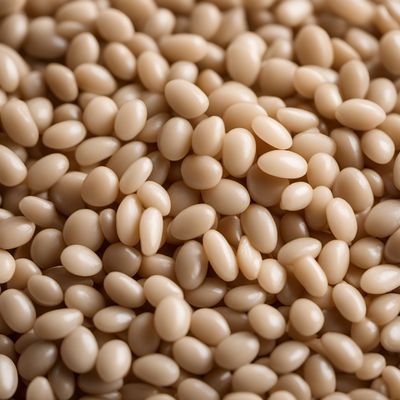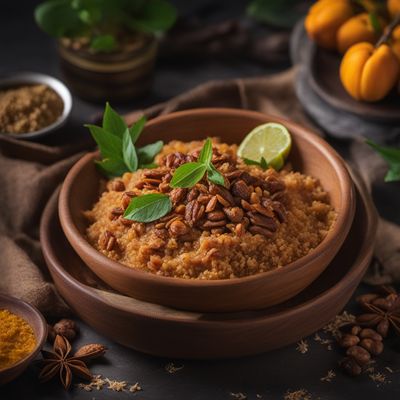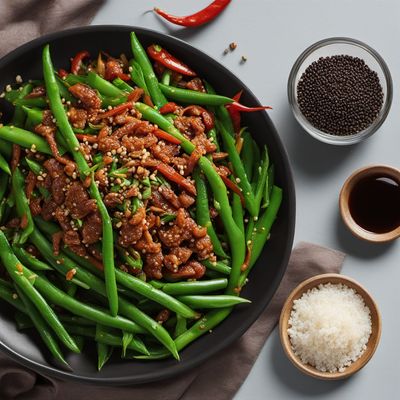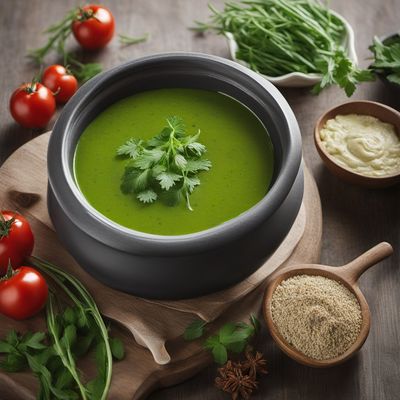
Ingredient
Yardlong beans (dry)
The Nutrient-Packed Legume: Yardlong Beans
Yardlong beans are long, slender pods that can grow up to a foot in length. They have a crisp texture and a slightly sweet flavor, similar to green beans. When cooked, they retain their crunch and add a refreshing element to stir-fries, salads, and soups. Yardlong beans are a popular ingredient in Asian cuisines, particularly in Chinese, Thai, and Indian dishes.
Origins and history
Yardlong beans have a long history and are believed to have originated in Southeast Asia. They have been cultivated for centuries and are a staple in many Asian cuisines. Yardlong beans are highly valued for their nutritional content and are known for their ability to thrive in hot and humid climates. They have become popular in other parts of the world due to their unique taste and versatility in cooking.
Nutritional information
Yardlong beans are a good source of dietary fiber, vitamins A and C, and potassium. They are low in calories and fat, making them a healthy addition to meals. However, individuals with legume allergies should exercise caution when consuming yardlong beans.
Allergens
Legume allergy
How to select
When selecting yardlong beans, look for pods that are firm, crisp, and vibrant green in color. Avoid beans that are wilted, discolored, or have blemishes. The beans should snap easily when bent, indicating freshness. If purchasing dried yardlong beans, ensure they are free from mold or insect damage.
Storage recommendations
To maintain the freshness of yardlong beans, store them in a perforated plastic bag or airtight container in the refrigerator. They can stay fresh for up to a week. Avoid washing the beans before storing, as moisture can accelerate spoilage.
How to produce
Yardlong beans can be grown in home gardens or containers. They require a warm and sunny location with well-drained soil. Sow the seeds directly in the ground or in containers, providing support for the vines to climb. Regular watering and occasional fertilization will promote healthy growth. Harvest the beans when they reach the desired length, typically around 12 inches.
Preparation tips
Yardlong beans can be prepared by trimming the ends and cutting them into desired lengths. They can be stir-fried, blanched, steamed, or added to soups and stews. Their crisp texture makes them an excellent addition to salads and pickles. Yardlong beans can be seasoned with various spices, herbs, and sauces to enhance their flavor. They pair well with garlic, ginger, soy sauce, and chili peppers.
Substitutions
Green beans can be used as a substitute for yardlong beans, although they have a slightly different texture. Asparagus can also be used as a substitute, offering a similar crispness and mild flavor. However, keep in mind that the taste and appearance may vary from the original dish.
Culinary uses
Yardlong beans are commonly used in Asian cuisines, particularly in stir-fries, curries, and salads. They can be stir-fried with other vegetables, added to noodle dishes, or used in soups and stews. In Chinese cuisine, they are often paired with garlic and fermented black beans. In Thai cuisine, yardlong beans are a key ingredient in dishes like pad prik king and green curry. They can also be pickled or blanched and served as a side dish.
Availability
Yardlong beans are commonly cultivated and consumed in Southeast Asian countries such as China, Thailand, Vietnam, and India. They are also available in specialty Asian markets and some supermarkets worldwide.
More ingredients from this category » Browse all

Vetches (dry)
The Nutrient-Packed Legume: Dry Vetches

Rice beans (dry)
The Versatile Powerhouse: Rice Beans

Jack beans (dry)
The Versatile Legume: Unveiling the Wonders of Jack Beans

Guar beans (dry)
Versatile Legumes: Guar Beans

Borlotti or other common beans (dry)
The Versatile Dried Beans

Soyabeans for consumption (dry)
The Versatile Legume

Ervils (dry)
The Nutritional Powerhouse: Exploring the Versatility of Dry Ervils

Black eyed peas (dry)
The Lucky Legume

Stink beans (dry)
The Aromatic Delight: Stink Beans

Monantha vetches (dry)
The Versatile Monantha Vetches

Broad beans (dry)
Hearty and Nutritious: The Dried Legume Powerhouse

Mung beans (dry)
The Mighty Green Legume
Recipes using Yardlong beans (dry) » Browse all

Berza Malagueña with Chorizo and Pork
Andalusian Delight: Hearty Berza Malagueña with a Twist

Malvani-style Gigandes Plaki
Spiced Gigantes Beans in Malvani Sauce

Creamy Coconut Vegetable Stew
Exquisite Coconut Delight: A Creamy Vegetable Stew

Indonesian Chinese Style Spiced Buccellato
Spiced Sweet Bread Delight: Indonesian Chinese Buccellato

Vegetarian Paella
Savor the Flavors of Spain with Vegetarian Paella

Zuppa di Taccole with Pancetta and Parmesan
Savory Green Bean Soup with Crispy Pancetta and Parmesan

Bonchi Kora Stir-Fry
Savory Korean Green Bean Stir-Fry

Chinese-style Braised Pork with Green Beans
Savory Pork and Green Beans Stir-Fry: A Chinese Delight

Javanese Tuna Pizza
Spicy Tuna Delight: Javanese Style Pizza

Equatorial Guinea-style Tofu and Vegetable Stew
Tropical Tofu Delight: Equatorial Guinea-inspired Kupat Tahu

Mtsvane Lobio with Herbed Yogurt Sauce
Savory Georgian Green Bean Stew with Creamy Yogurt Sauce

Huaiyang-style Sweet Soup
Silky Delights: Huaiyang-inspired Sweet Soup